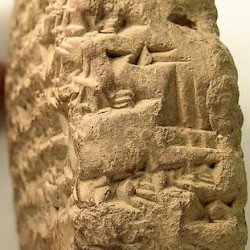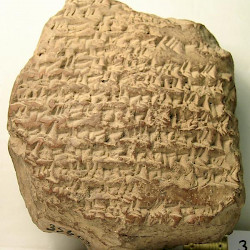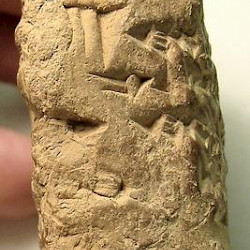CM 4 (Babylonian King List of the Hellenistic Period)
The Babylonian King List of the Hellenistic Period (also known as "King List 6") is an important historiographical document from ancient Babylonia.
The Babylonian King List of the Hellenistic Period (also known as "King List 6") is an important historiographical document from ancient Babylonia. It mentions the length of the reigns of several kings, beginning with the accession of Philip Arridaeus, the brother of Alexander the Great, in June 323, and continuing to the reign of the Seleucid king Antiochus IV Epiphanes (r.175-164). Together with the Uruk King List, the Babylonian King List of the Hellenistic Period is a useful text for those who are reconstructing the chronology of Babylonia in the late fourth to mid-second centuries.
The cuneiform tablet (BM 35603 = Sp. III 113) is in the British Museum. On this website, you will find a new transciption and translation by Bert van der Spek of the Free University of Amsterdam (Netherlands), who has recently restudied this tablet as part of his publication of the Babylonian Chronicles of the Hellenistic Period. He also took the photos.note
Description of the tablet
The tablet measures about 80 x 65 mm and is written in a late Babylonian script. The only exception is the archaic spelling of the AG sign. As Grayson has suggested, this suggests that "the original editors observed that the scribe was conscious of the antiquity of the king list tradition in Babylonia and of the fact that he was perpetuating this tradition in his own time".
Since Demetrius II (r.145-125 BCE) is mentioned on the left edge the tablet was probably inscribed in his reign.
Previous editions:
Iraq 16 (1954) 202-212. - A.K. Grayson, from the Reallexikon der Assyriologie, s.v. "Königslisten und Chroniken".
- Del Monte 1997 (TBE) p. 208-211
- Glassner 2004 (CM) no. 4, p. 134-135
Note
There are very strong indications that the following translation needs to be revised.
- The third line on the obverse may actually be "when the king was not in the country" (the sign [...]MU may be read as UMU). In other words, Antigonus Monophthalmus has no Babylonian regnal years.
- The tablet contains lacunae where the regnal years of Seleucus II and Seleucus III should have been mentioned; the restoration offered below is almost certainly incorrect.
[Obv.1] [...] Alexand[er III] [...]
[Obv.2] [Ph]ilip, brother of Alexander, […].
[Obv.3] For [n] years there was no king in the country. Antigonus,
[Obv.4] general-in-chief of the army, ruled the land.note
[Obv.5] Alexander [IV], son of Alex[ander III]: 6 years?.
[Obv.6] Year 7, which is year 1: Seleucus (I Nicator was) king.note
[Obv.7] He reigned for twenty-five years.
[Obv.8] Year 31, Ulûlu [= month VI]: Se(leucus I), the king, was killed in the land of the Hanaeans.
[Obv.9] Year 32 [280/279]: An(tiochus I Soter), son of Se(leucus I, was) king. He reigned twenty years.note
[Obv.10] Year 51: Ajaru [= month II], on the sixteenth day, An(tiochus I), the great king, died.
[Obv.11] Year 52 [260/259]: An(tiochus II Theos), son of An(tiochus I was) king. [He reigned] 15 <years>.
[Obv.12] Year 66, Abu [= month V]: It was heard in Babylon
[Obv.13] as follows: "An(tiochus), the son of An(tiochus), the great king, has died."
[Obv.14] [Year] 67 [245/244]: S[e(leucus II Callinicus), the son of An(tiochus II was) king. He reigned 20? years]
[Obv.15] [...]
[In the lacuna between the obverse and reverse, we would expect references to the death of king Seleucus II Callinicus (after 18 September 226) and the accession of Seleucus III Keraunos (before 10 April 225).]
[Rev.1] [Year] 87 [225/224]: Se(leucus III Keraunos was) [king. He reigned 3 years]
[Rev.2] Year 90 [222/221]: An(tiochus III the Great), the king, as[cended] the throne.
[Rev.3] He reigned for 35 [years].
[Rev.4] From the 102th year [210/209] until (year) 119 [193/192] An(tiochus) [the king?]
[Rev.5] and An(tiochus), his son!, were kings!.
[Rev.6] Year 125, Simanu [= month III]: It was heard in Babylon:
[Rev.7] as follows: "On the twenty-fifth day An(tiochus III), the king, was killed in Elam"
[Rev.8] The same year: Se(leucus IV Philopator), his son, ascended the throne. He reigned for twelve years.
[Rev.9] Year 137, Ulûlu [= month VI], the tenth: Se(leucus IV), the king, died...
[Rev.10] The same month: An(tiochus IV Epiphanes), his son,note ascended the throne. He reigned for eleven years.
[Rev.11] The sam[e year], Arahsamna [= month VIII]: An(tiochus IV) and An(tiochus), his son, [were] kings.
[Rev.12] [Year 1]42, Abu [= month V]: At the command of An(tiochus IV), the king, An(tiochus), the king, his son, was killed.
[Rev.13] Year 143 [169/168]: An(tiochus IV was sole) king.
[Rev.14] Year 148, Kislîmu [= month IX]: It was heard that An(tiochus IV), the k[ing died].
[Rev.15] [...] x x x [...]
[Upper edge.1] [(...)]
[Upper edge.2] [...] A x [...]
[Upper edge.3] [...] x x [...]
[Left edge.1] [Year ...] De(metrius II Nicator), son of king De(metrius I Soter), [was king...]
[Left edge.2] [...] x Ar(saces)? k[ing? ...]



